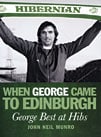 George Best at Hibs
George Best at Hibs
by John Neil Munro
Birlinn, £9.99
Reviewed by Graham McColl
From WSC 289 March 2011
Scottish club football began the 1970s in the cigar-toting strata of European football, but by the end of the decade it was doing the equivalent of rummaging around looking for fag-ends. Hibernian, whose hugely progressive Turnbull's Tornadoes side had jousted with the likes of Sporting Lisbon and Liverpool early that decade, were chief among the Scottish game's derelicts by the closing weeks of 1979. The Edinburgh club was in an abject state and heading for relegation.
The parachuting of George Best into this moribund scene, in late November 1979, was a bit like a backstreet second-hand-car lot suddenly showcasing a vintage Aston Martin; a stunt to be admired for its sheer chutzpah as long as the bodywork was not scrutinised too closely. When George Came To Edinburgh is an affectionate look at the intrigue-filled year that followed.
There are some eerily familiar aspects to the tale. On first meeting Tom Hart, the Hibs chairman and the man prospectively bankrolling Best's phenomenal wages, George impresses the Hibs directors by drinking orange juice at lunch, while everyone else is partaking of champagne. Within a month, George has reverted to type. He misses training, goes on a three-day bender in Manchester and arrives in Glasgow on a Saturday morning, drunk, hours before the kick-off of a match at Morton.
Hart, whose prize signing had been trebling gates home and away, offers Best the all-round, face-saving compromise of getting stripped but sitting on the subs' bench, with Hibs ready to tell press and public that the player is nursing an injury. Best responds: "I could try to sit on the bench, Mr Hart, but I might fall off."
At Ibrox, in front of more than 30,000 people, he takes the field against Rangers with the Hibs management fully aware that he is drunk and plays quite well. A heavily patched-up Peter Cormack is in midfield alongside him and Tony Higgins, left out of the team, turns to Jackie McNamara and says: "McNamara, we must be really good players when a cripple and a drunk can get a game before us."
Best, at Hibs, retained the brain of a footballing genius but, thanks to his body having undergone so much punishment, on and off the field, by that stage in his life it was like having a state-of-the-art penthouse suite located inside a condemned building. The 33-year-old's talents would flicker into life only occasionally – although when they did, they could still light up the dullest of matches.
The brevity of the period Best spent with Hibs helps the author to go into the finest of detail in relating the tale. For example, despite the club paying the sizeable sum of £60,000 for Best's registration, plus a personal appearance fee of £2,500 per match, which put him among Britain's best-paid players, a written contract was never drawn up. The entire transaction settled on a handshake between Best and Hart.
Neither judgmental of Best nor glorifying in his excesses, When George Came To Edinburgh is an insightful, engrossing and rounded account of one of the most bizarre and fantastical episodes Scottish football has ever witnessed.